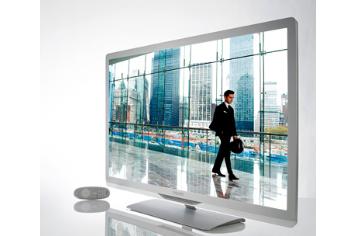What Hi-Fi? Verdict
It doesn’t offer the very best picture quality in its class, but Philips’ Econova is a great compromise between eco friendliness and outright performance
Pros
- +
Lovely styling
- +
recycled and recyclable
- +
remarkably low power consumption for a flatscreen
- +
likeable pictures from all sources
- +
stable upscaling of SD
- +
decent sound
Cons
- -
Lacks the detail, colour neutrality and motion handling of the best in class
- -
no Freeview HD
Why you can trust What Hi-Fi?
Home cinema kit might be a minor contributor to climate change when compared to, say, cars and bovine emissions, but there's nothing wrong with the industry making the effort to go a little green.
With the 42PFL6805H Econova TV, Philips really is doing its bit. Here's a 42in TV made from 60 per cent recycled aluminium and is designed for easy disassembly and recycling at the end of its life.
There's no plastic or polystyrene in its packaging, either. It's made entirely from paper monomaterials that are 100 per cent recyclable.
The instruction manual is built into the TV's menus so there's no need for a wasteful paper one, and the pedestal stand doubles as a wall bracket so there are no unnecessary or unused components. You even get a solar powered remote control.
If talk of a TV built from recycled materials fills you with visions of a unit consisting of a patchwork mess of hurriedly welded together sheets of corrugated iron, Scrapheap Challenge-style, you'll be very pleasantly surprised. This really is a beautiful TV by any standards.
LED backlight saves energy
Thanks to edge LED backlighting it's slim, too, but the real reason for going with LED is the efficiency it offers over traditional technology.
Of course, loads of TVs are turning up with this tech now, but thanks to a host of energy-saving options and a very efficient and precise ambient light sensor, Philips has managed to get the Econova's typical power consumption down to just 46W, which is approximately half that of other LED TVs, such as the 7-series Philips on which it's based.
Ambilight is obviously a huge power drain, so it's been removed for the Econova. However, the 7-series' picture-processing options, such as 100Hz Clear LCD and Pixel Precise HD, remain.
It also boasts four HDMI inputs (one that's compatible with audio-return channel) and a USB connection that allows you to access your digital photos, MP3s and movie files.
Effective eco picture modes
Of course, with this being a Philips, picture calibration is something of a pain, and the addition of eco settings makes it a little more complicated.
The good news, though, is that after much experimentation we found the best picture involved the use
of the light sensor and active backlight, which in partnership ensure the TV is only ever using as much power as the onscreen action and ambient light requires.
Watch our video review of this set
So just how good is this ‘best picture'? Very good indeed. Play the ever challenging Harry Potter and the Order of the Phoenix and it's immediately clear that the '6805 is built to perform as well as save the planet.
As the camera descends over the sleepy town of Little Whinging, the Econova grips the tightly packed houses and moving cars with easy solidity, and the colour palette backs-up the overheard weather report with dry, sun-scorched fields.
Motion doesn't cause a splash
There's enough insight to reveal skin imperfections and clothing textures as the camera focuses on the characters, and the Philips proves it's got the contrast levels to provide decent, detailed blacks and plenty of punch.
In its own right, then, the Econova is very good – but next to the best it's a touch warm and soft.
In some ways, that's quite likable, as you get a vibrant, easy-going presentation of almost any
disc – but it isn't quite as natural or dynamic as that offered by the most neutral, punchy and detailed sets.
We're also left disappointed again with the smeary way Philips handles challenging horizontal motion.
The Econova does get closer to its rivals with other sources, though. Ask it to upscale the Greenberg DVD and it will do so with very impressive stability and detail recovery, and that picture warmth, though still evident, is less obvious.
No Freeview HD tuner
Switch to the TV tuner and we're once again left lamenting Philips' decision to omit Freeview HD from its sets this year – but at least its standard-def channels are presented in clean and clear style.
Where Philips does frequently get the better of its rivals is in the flatscreen sound department, and although the Econova lacks the sonic authority of its more premium stablemates, the overall delivery is very direct and weighty by the standards of the class.
Overall, though, Philips' Econova TV isn't the best performer in the 40-42in TV class, but it's not far off the best – and given that it is the most efficient and eco-conscious, that's very impressive indeed.
What Hi-Fi?, founded in 1976, is the world's leading independent guide to buying and owning hi-fi and home entertainment products. Our comprehensive tests help you buy the very best for your money, with our advice sections giving you step-by-step information on how to get even more from your music and movies. Everything is tested by our dedicated team of in-house reviewers in our custom-built test rooms in London, Reading and Bath. Our coveted five-star rating and Awards are recognised all over the world as the ultimate seal of approval, so you can buy with absolute confidence.


